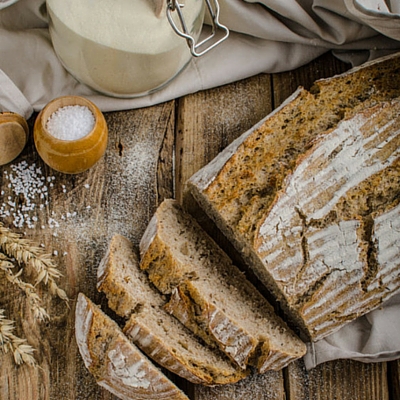
Sourdough bread
Creating sourdough might just be one of the simplest things to make in the world of baking. Just blend flour and water and let sit for a minimum of 12 hours so the lactic acid bacteria and wild yeasts can work their magic. Then it is added at 5-50% on flour weight in your recipe and you’ll be savoring delicious sourdough bread!
The challenging task lies in maintaining a consistent quality of sourdough. After all, this natural fermentation depends on the skill set of the baker and the ability to control the variances in ingredients (primarily flour) and process (time and temperature).
For those who want to concentrate chiefly on baking bread, while leaving sourdough to the specialists, ingredient companies have developed a wide range of sourdough products over the years that are ready-to-use. These products appear in both liquid or powder form and offer not just the flavorful taste of sourdough you’ve come to cherish, but also advantages such convenience and consistency in finished applications.
Production of Commercial Sourdough Products
It all starts with the natural fermentation of flour, water and microorganisms- no different than your traditional artisan sourdough process. In large temperature controlled fermentation tanks, flour and water are blended with specific lactic acid bacteria and wild yeasts. Essentially, this eliminates any opportunity for growth of lactic acid bacteria or microorganisms that are airborne or already present on the flour Typically, the selection of the type of flour (wheat, rye, whole wheat, oat, spelt, etc.) will also determine the final flavor of the sourdough. Similar to other fermented foods, such as wine or cheese, where long fermentation times give way to more flavor, some sourdough profiles can take up to four days to develop in just the right way. At this stage, the sourdough is ready but needs to be stabilized for convenience of use.
Types of Commercial Sourdough Products
For liquid sourdough products, a cooling or heating step is part of the process. Cooling the it will keep all micro-organisms alive but dormant, whereas the heating step will deactivate the micro-organisms, consequently stopping the fermentation effect of the sourdough. A cooled sourdough needs to be shipped and stored in refrigerated conditions and thus, has a limited shelf life. Heated liquid sourdoughs offer greater flexibility in terms of shipping and shelf life. These liquid sourdoughs can be stored for up to 9 months in ambient temperature.
If you require sourdough in powdered form, this is obtained after the sourdough fermentation. The technology used involves warm air drying or contact drying, that will influence the flavor desired from the powdered sourdough.
The spray drying process consists of warm air gently evaporating the water from the sourdough, and subsequently provide subtle and complex flavor notes. In contrast, contact drying, i.e. drum drying, will enhance caramelization and toasted notes.
The aforementioned parameters (selection of flour, type of lactic acid bacteria, fermentation parameters, downstream process and physical format) enable the development of a wide range of sourdough products based on a natural fermentation process, each with a different flavor profile.
Besides the convenience of being ready-to-use, these products provide additional advantages like speed of development, exact costing and the innovation to invent signature flavors. These sourdoughs can also be added on top of existing recipes already containing sourdough to help stabilize flavor and bring more consistency to bakery products.
To learn about the world of sourdough products, visit our sourdough library.
HAPPY NATIONAL SOURDOUGH DAY!


